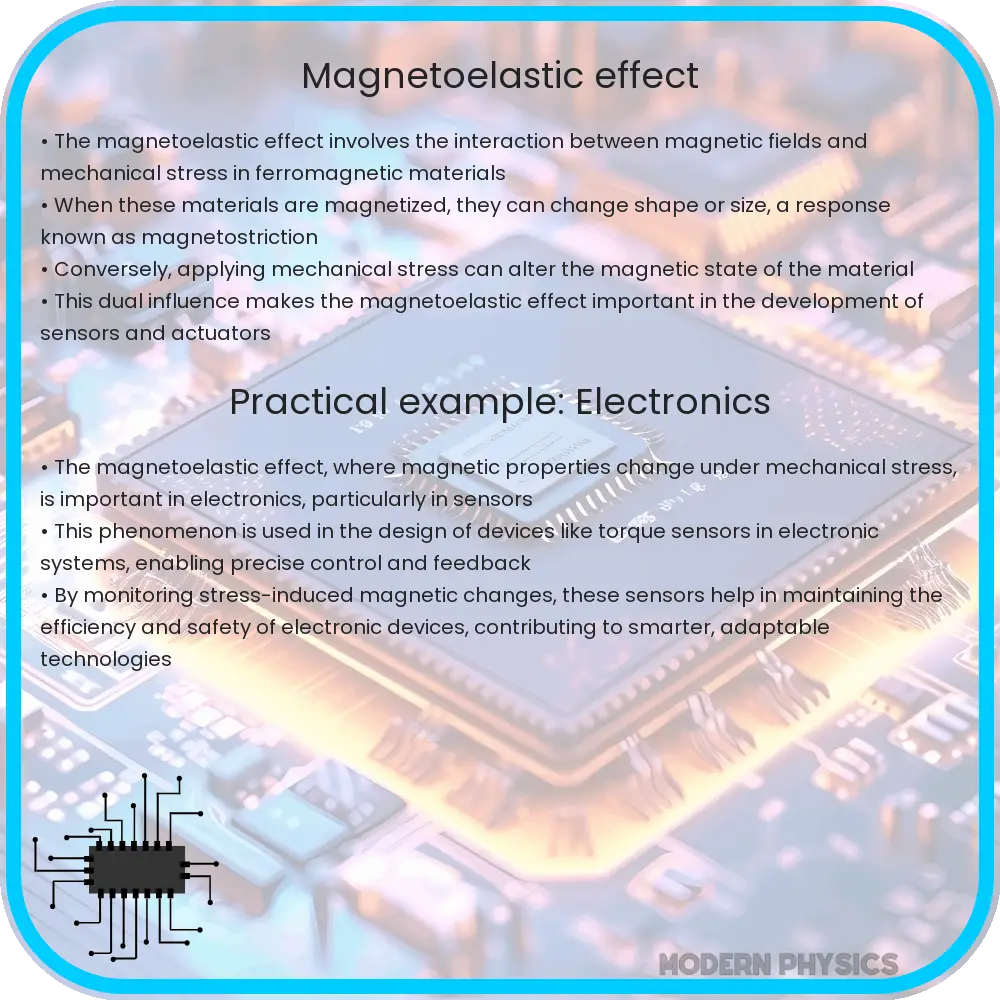Explore the magnetoelastic effect, its theory, and diverse applications in technology, from sensors to energy harvesting and structural health.

Magnetoelastic Effect: Understanding Its Influence and Applications
The magnetoelastic effect, a fascinating phenomenon in material science, refers to the interaction between magnetic and elastic properties of materials. When a magnetic material is subjected to mechanical stress, it experiences a change in its magnetization, and conversely, when it is exposed to a magnetic field, its shape or dimensions alter. This effect plays a crucial role in various technological applications and advances our understanding of material behavior under different conditions.
Theoretical Background
At the core of the magnetoelastic effect lies the coupling between a material’s magnetic domain structure and its lattice structure. This interaction is governed by two primary mechanisms: magnetostriction and the Villari effect. Magnetostriction describes the change in a material’s dimensions upon magnetization, often observable in ferromagnetic materials like iron (Fe), nickel (Ni), and cobalt (Co). Conversely, the Villari effect refers to the change in magnetization under applied mechanical stress.
The theory behind this effect is rooted in the alignment of magnetic domains. In an unmagnetized state, these domains are randomly oriented. However, when subjected to a magnetic field, the domains align along the field, causing a change in the material’s shape. The extent of this change is quantified by the magnetostriction coefficient, λ, a dimensionless number representing the strain per unit magnetization.
Applications in Technology
The practical applications of the magnetoelastic effect are diverse and impactful. One of the most notable uses is in sensors and actuators. Magnetoelastic sensors, for example, are employed in torque and force measurement devices, where changes in magnetic properties under stress provide precise readings. Similarly, in the field of telecommunications, magnetoelastic materials are used in filters and resonators due to their ability to convert magnetic energy into mechanical vibrations, and vice versa.
Another significant application is in the realm of magnetic storage media. The magnetoelastic effect contributes to the optimization of recording media by enhancing the sensitivity and accuracy of data storage and retrieval. This is particularly important in high-density magnetic recording systems.
Additionally, the study of magnetoelastic effects has also led to advancements in smart materials and nanotechnology. For instance, magnetoelastic thin films and nanoparticles show promising applications in targeted drug delivery systems, where a magnetic field can control the release of medication.
Further Insights into Magnetoelastic Phenomena
The exploration of magnetoelastic effects extends into the realms of energy harvesting and structural health monitoring. In energy harvesting, magnetoelastic materials can be used to convert mechanical energy, such as vibrations from industrial machinery or infrastructural elements, into electrical energy. This approach has significant potential for sustainable energy solutions.
In structural health monitoring, the sensitivity of magnetoelastic materials to stress and strain makes them ideal for detecting flaws or changes in infrastructure, such as bridges or buildings. Embedding magnetoelastic sensors within these structures enables real-time monitoring and early detection of potential problems, thereby enhancing safety and longevity.
Challenges and Future Directions
Despite its numerous applications, the magnetoelastic effect presents challenges in terms of material optimization and control. Achieving a high degree of sensitivity while maintaining material stability is a key research focus. Advances in nanotechnology and materials science are paving the way for the development of new magnetoelastic materials with improved properties, such as higher magnetostriction coefficients and better temperature stability.
The integration of magnetoelastic materials with other technologies, such as microelectromechanical systems (MEMS) and nanoelectromechanical systems (NEMS), is another area of active research. This integration promises to enhance the performance and expand the capabilities of devices across various fields, from medical technology to aerospace engineering.
Conclusion
The magnetoelastic effect represents a critical intersection of magnetism and material science, offering a window into the complex interactions within materials. Its applications, ranging from advanced sensors to energy harvesting, highlight its versatility and potential for innovation. As research continues to overcome existing challenges and explore new possibilities, the magnetoelastic effect will undoubtedly play a pivotal role in the technological advancements of the future. Embracing this effect not only pushes the boundaries of material science but also opens doors to a myriad of applications that could revolutionize various aspects of our lives.
